Exploring unusual food from around the world can be both surprising and fascinating. Traveling opens your eyes—and your taste buds—to the fascinating flavors and dishes that exist worldwide. Around the globe, adventurous eaters indulge in some incredibly strange meals, many that might surprise or even shock you. But don’t be fooled; each quirky delicacy tells a meaningful story, rooted deeply in local tradition and history. What may seem unusual or even bizarre to one culture often represents comfort food or special celebrations to another. From crunchy insects and fermented fish to foods that move when you bite them, every unusual meal has a tale worth telling. So pack your imaginary bags, open your mind, and prepare your palate. We’re about to explore 30 of the most wonderfully weird and culturally unique foods from across the world, one deliciously daring bite at a time.
1. Surströmming – Sweden

Surströmming is a type of fermented herring that is famously pungent. It’s a Swedish delicacy, usually enjoyed outdoors because of its powerful odor. The fish ferments inside sealed cans, building up a potent aroma over several months. When the can is finally opened, the strong smell can overwhelm those who aren’t accustomed to it. Locals typically serve it on flatbread with potatoes, onions, and a dollop of sour cream. Despite its powerful smell, surströmming remains popular in Sweden, especially during late-summer celebrations. It’s a food that often sparks debate—but one deeply tied to Swedish tradition.
2. Balut – Philippines

Balut is an unusual food popular in the Philippines, consisting of a partially-developed duck egg. The egg is boiled, seasoned with salt or vinegar, and eaten directly from the shell. Inside, the embryo, yolk, and broth combine to offer a surprisingly savory taste. Although it may appear intimidating, balut is highly nutritious and is considered an energy booster. Locals commonly enjoy it as a street snack or late-night comfort food. Many travelers find it challenging to try, yet those who do often appreciate the unique flavor. Balut symbolizes both culinary creativity and cultural pride in Filipino cuisine.
3. Fried Tarantulas – Cambodia
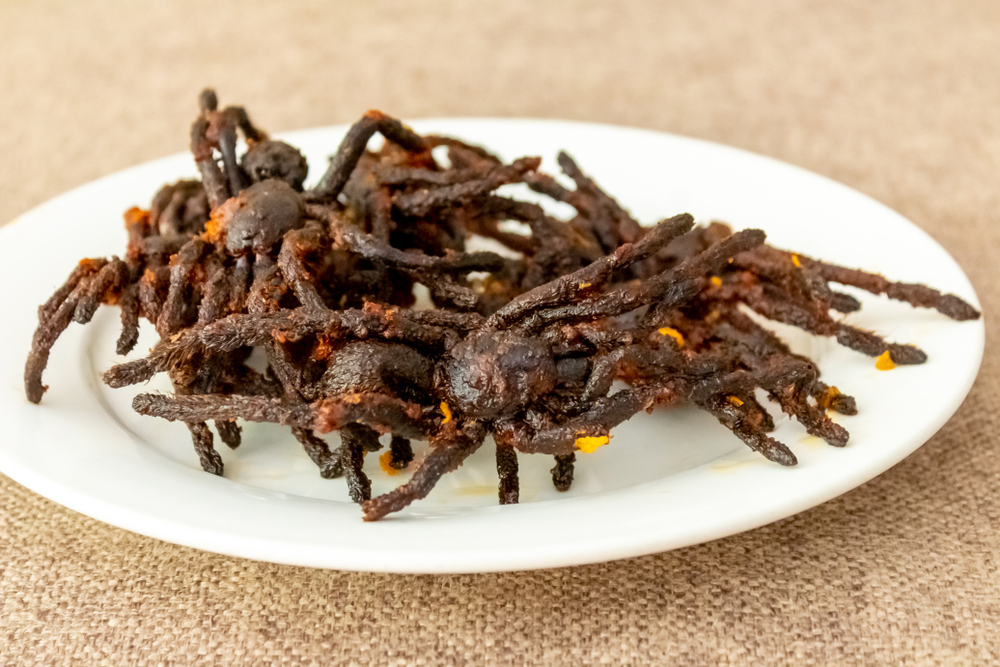
In Cambodia, fried tarantulas have evolved from survival food into a regional delicacy. The dish became popular during the food shortages of the Khmer Rouge period, but it remains beloved today. Locals prepare these spiders by seasoning them with salt, garlic, and sugar, then frying them until crisp. They’re often sold by vendors in the town of Skuon, affectionately nicknamed “Spiderville.” The taste resembles crispy chicken or crab, while the texture is crunchy on the outside and softer within. Fried tarantulas have also become a unique attraction for adventurous travelers eager to experience Cambodian food culture firsthand. This unusual food serves as a reminder of resilience and innovation during tough times.
4. Casu Marzu – Italy
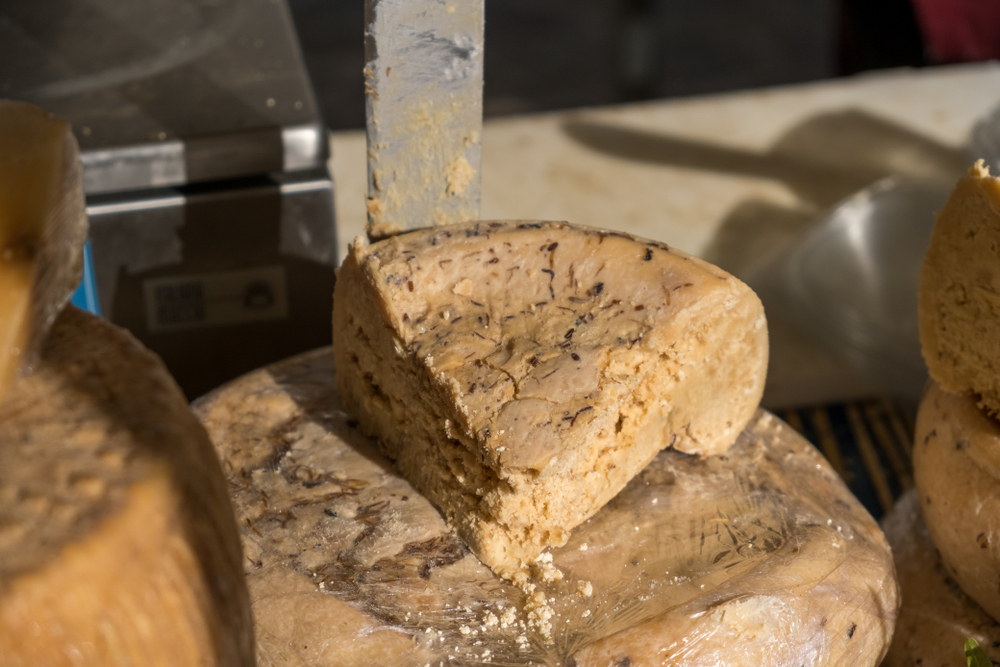
Casu Marzu is an infamous cheese from Sardinia, Italy, known for its unusual preparation. Made from sheep’s milk, it is intentionally exposed to cheese flies, whose larvae transform its texture dramatically. These tiny larvae digest the cheese, making it exceptionally soft, creamy, and pungent. The presence of live larvae within the cheese has led to its ban by health authorities, though it remains quietly enjoyed in Sardinia. Those who eat Casu Marzu claim it has an intense, rich flavor unlike any other cheese. However, the idea of consuming cheese that contains live insects is understandably off-putting to outsiders. Despite the controversy, Casu Marzu remains a unique and cherished local specialty.
5. Hákarl – Iceland
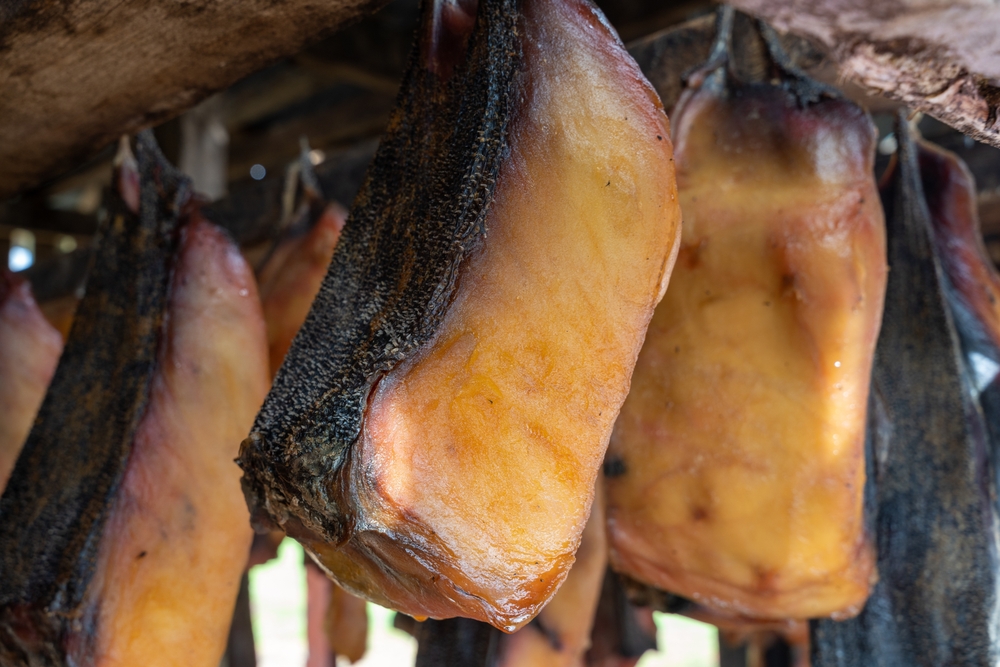
Hákarl is a traditional Icelandic delicacy made from fermented Greenland shark meat. Fresh shark meat contains toxins, so Icelanders developed a method of fermenting the meat underground to make it safe to eat. The fermentation and drying process can take several months, resulting in a strong ammonia smell and distinctive taste. Many who taste hákarl for the first time find its pungent aroma and intense flavor challenging. Icelanders often serve hákarl in small cubes accompanied by a shot of brennivín, a traditional liquor. Eating hákarl is viewed as a cultural experience, symbolizing heritage and resilience in Iceland. This unusual food continues to fascinate visitors and locals alike, illustrating the creativity involved in traditional food preservation methods.
6. Century Egg – China
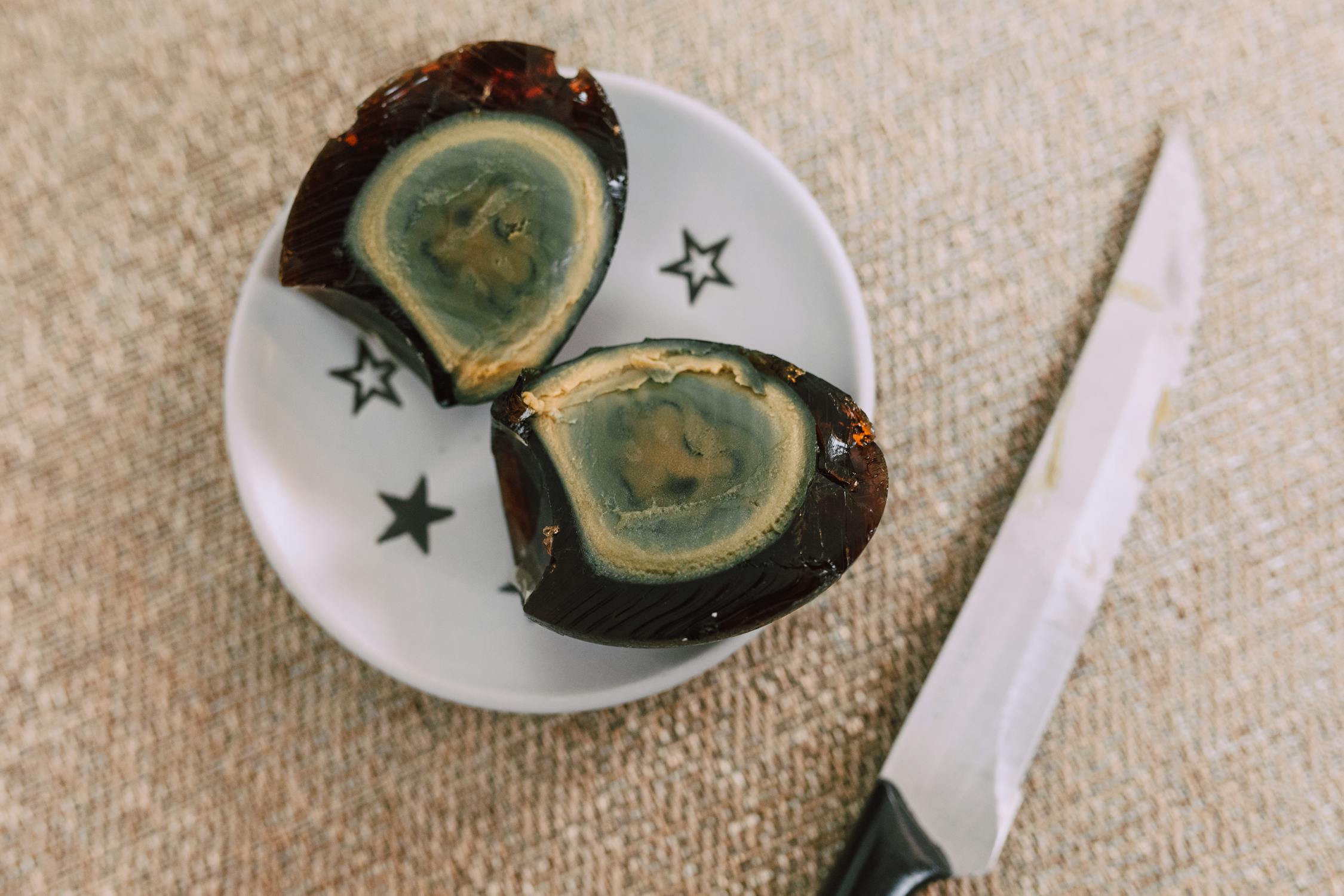
The century egg, also known as a hundred-year egg or preserved egg, is a Chinese delicacy with a history spanning centuries. Despite its name, this unusual food is not actually aged for a hundred years; rather, it’s preserved for several weeks to months. The preservation process involves encasing duck, chicken, or quail eggs in a mixture of clay, ash, salt, quicklime, and rice hulls. Over time, this transforms the egg white into a dark, translucent jelly and the yolk into a creamy, dark green or gray substance. The flavor is rich and complex, often described as pungent with a hint of ammonia, which can be an acquired taste for some. Century eggs are typically enjoyed as a side dish, sliced and served with pickled ginger, or incorporated into rice porridge. They hold a cherished place in Chinese cuisine, symbolizing the art of preservation and culinary tradition.
7. Sannakji – South Korea
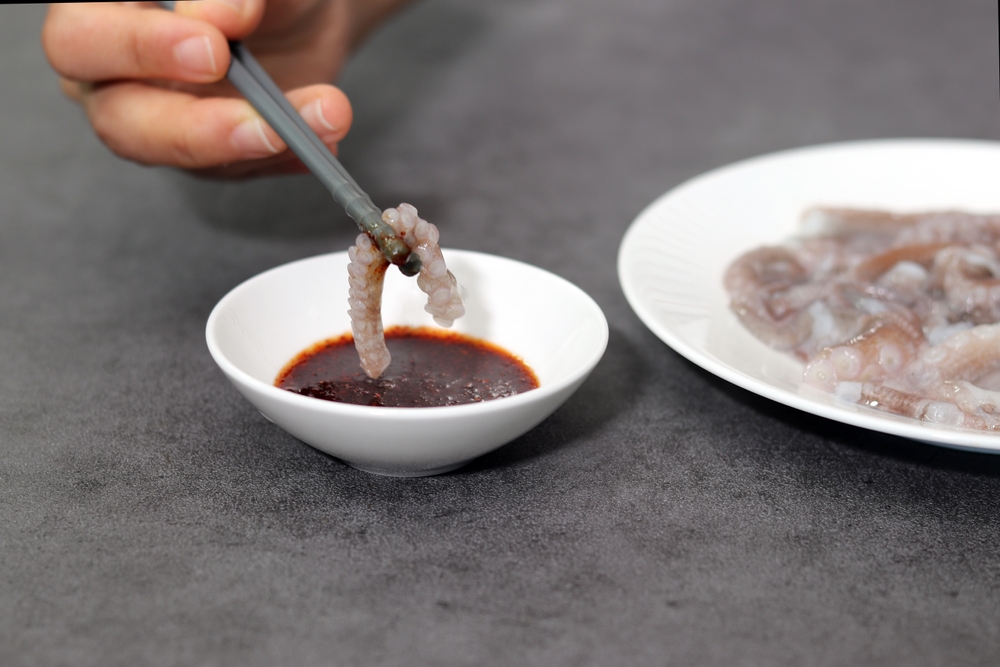
Sannakji is a Korean delicacy that features live octopus, offering a truly unique dining experience. The dish consists of a small octopus that is cut into pieces and served immediately, with the tentacles still wriggling on the plate. Diners often dip the pieces into sesame oil mixed with salt, enhancing the subtle, oceanic flavor. The sensation of the moving tentacles can be both thrilling and challenging, as the suction cups may cling to the mouth. Due to this, it’s important to chew thoroughly to prevent any choking hazard. Sannakji is popular in South Korea’s seafood markets and is believed to provide stamina and health benefits. This unusual food exemplifies the adventurous spirit of Korean cuisine and its emphasis on fresh, dynamic ingredients.
8. Escamoles – Mexico

https://www.shutterstock.com/image-photo/escamoles-delicious-mexican-caviar-guacamole-dip-1465862210
Escamoles, often referred to as “insect caviar,” are the edible larvae of ants harvested from the roots of agave plants in Mexico. This unusual food has been consumed since the time of the Aztecs and remains a delicacy in Mexican cuisine. The larvae are creamy-white and have a texture akin to cottage cheese. When cooked, usually sautéed with butter, garlic, and spices, they offer a nutty, buttery flavor that is highly prized. Escamoles are commonly served in tacos or omelets, providing a unique twist on traditional dishes. Harvesting these larvae is a labor-intensive process, contributing to their status as a gourmet item. Their consumption highlights the resourcefulness and depth of Mexico’s culinary heritage.
9. Haggis – Scotland
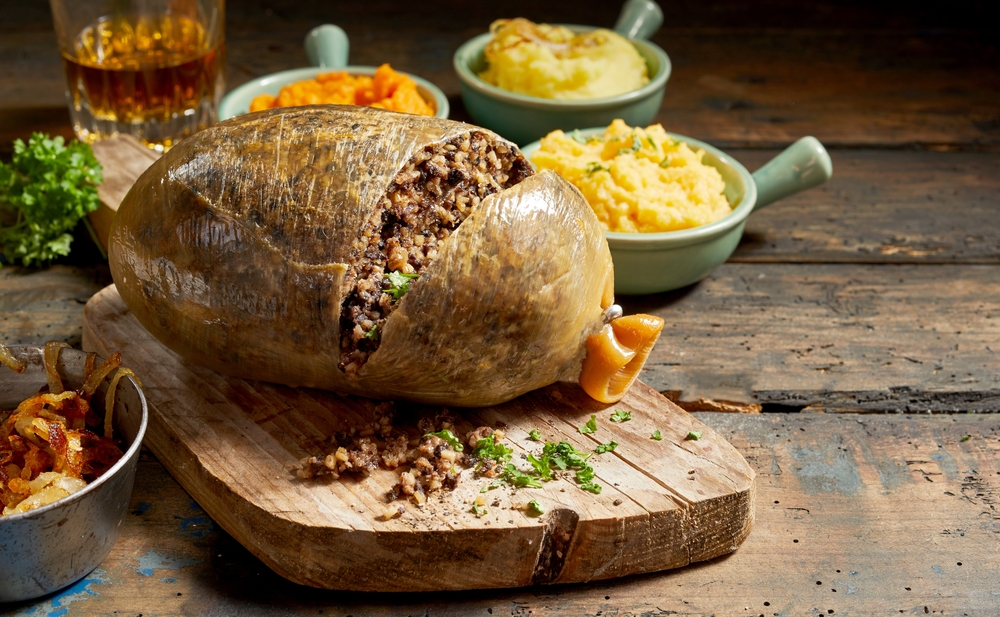
Haggis is Scotland’s national dish, celebrated for its rich flavor and cultural significance. This savory pudding combines minced sheep’s heart, liver, and lungs with onions, oatmeal, suet, spices, and salt. The mixture is traditionally encased in the animal’s stomach and simmered for several hours. The result is a hearty, flavorful dish with a crumbly texture, often described as earthy and peppery. Haggis is typically served with “neeps and tatties” (mashed turnips and potatoes) and a dram of Scotch whisky. It takes center stage during Burns Night celebrations, honoring the poet Robert Burns, who famously praised the dish. Despite its unusual ingredients, haggis embodies the Scottish ethos of resourcefulness and respect for the whole animal.
10. Gator Tail – Florida, United States
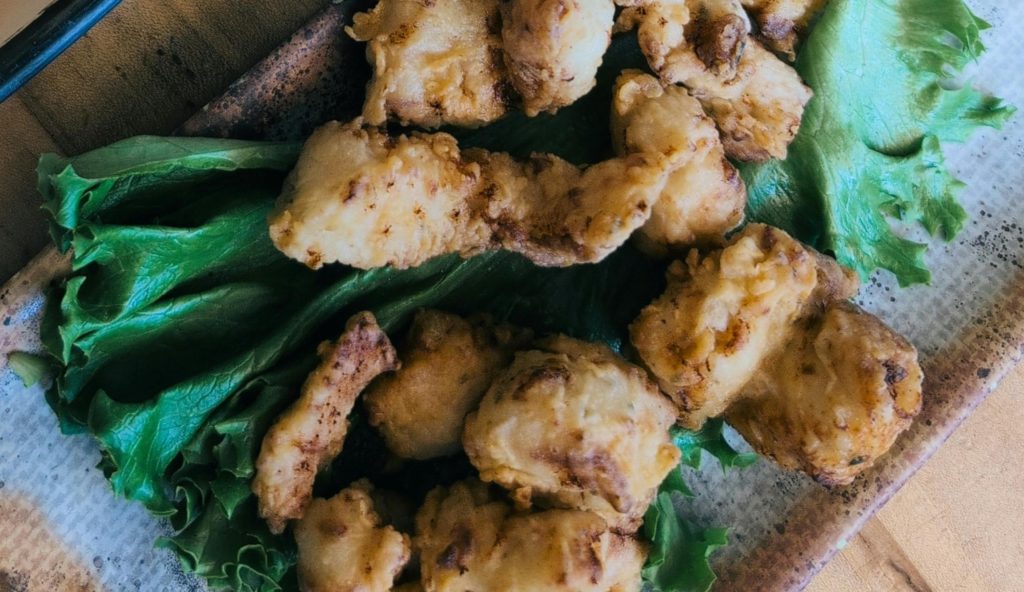
Gator tail is a uniquely Floridian specialty that has become increasingly popular across the southern United States. Harvested primarily from alligators found throughout Florida’s swamps and marshlands, the tail meat is prized for its tenderness and mild flavor. Once cleaned and prepared, the meat is typically cut into bite-sized pieces, lightly seasoned, battered, and deep-fried until crispy. Many who taste gator tail for the first time compare its flavor to a mix between chicken and fish, with a texture that’s tender yet slightly chewy. Restaurants often serve gator tail as an appetizer alongside tangy dipping sauces, like Cajun remoulade or spicy aioli. Eating gator tail provides insight into Florida’s distinct food culture, highlighting local traditions and wildlife. While initially an adventurous choice, it’s now celebrated as a delicious staple of regional cuisine.
11. Fugu – Japan
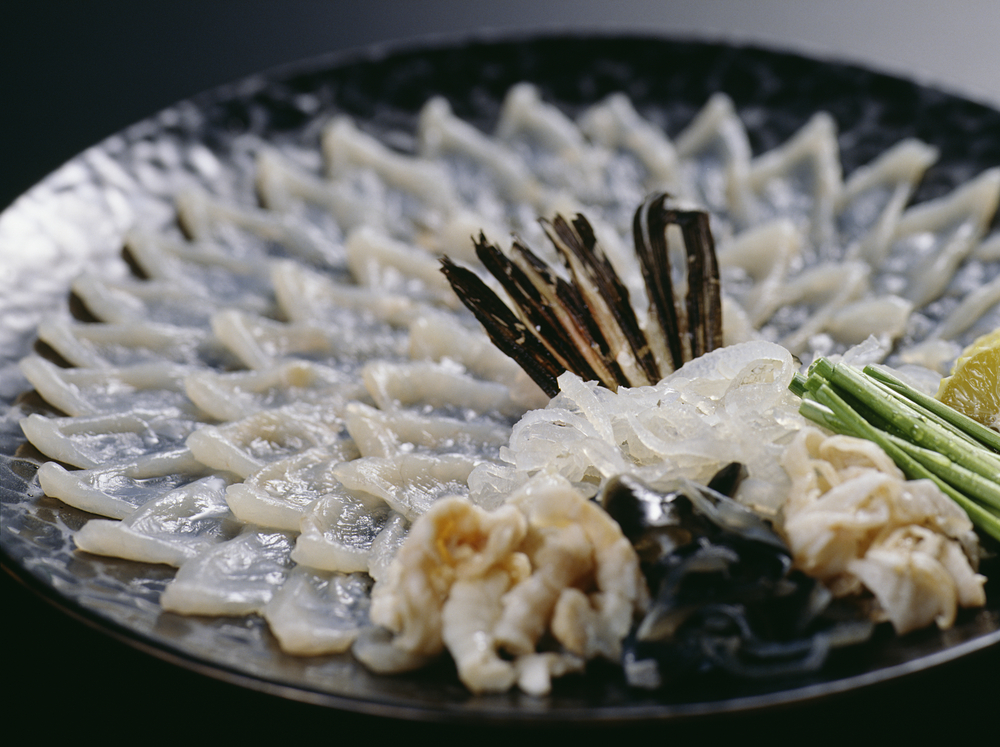
Fugu, or pufferfish, is a Japanese delicacy renowned for its exquisite taste and the meticulous preparation it demands. The fish contains tetrodotoxin, a potent neurotoxin that can be lethal if ingested. Only licensed chefs, who undergo rigorous training and certification, are permitted to prepare and serve fugu. The most popular serving method is sashimi, where the thinly sliced fish is presented in intricate patterns. Diners describe its flavor as subtle and its texture as uniquely chewy. Despite the inherent risks, fugu remains a sought-after dish, symbolizing both the precision of Japanese culinary arts and the adventurous spirit of its patrons.
Read More: 20+ Of The World’s Most Beautiful Destinations
12. Rocky Mountain Oysters – United States
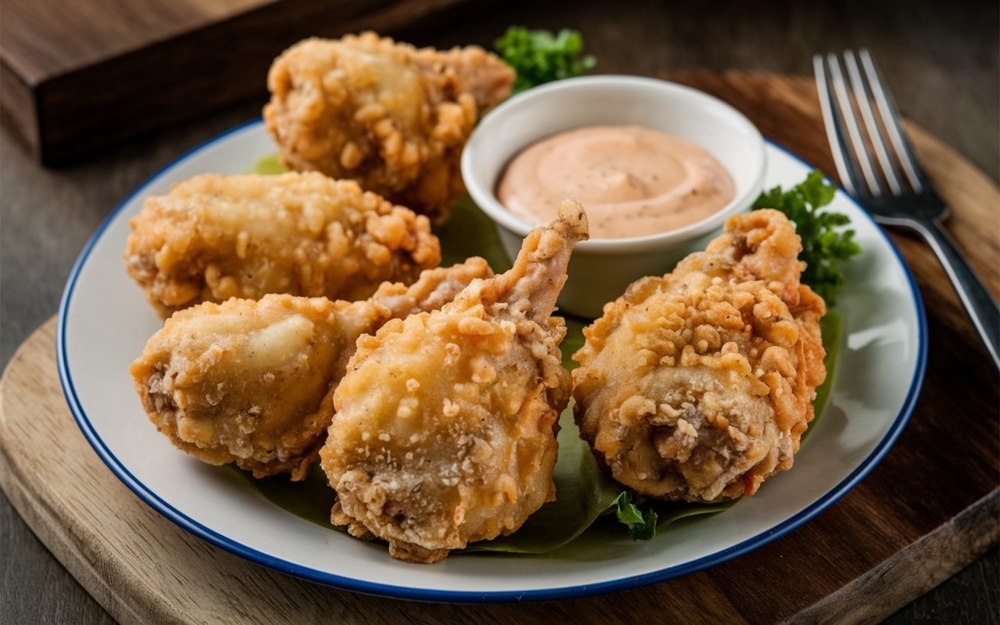
Despite their name, Rocky Mountain oysters are not seafood but rather deep-fried bull testicles, a dish popular in parts of the American West. Traditionally prepared by peeling, slicing, breading, and frying, they are often served with dipping sauces. The flavor is akin to other organ meats, with a texture that combines a crispy exterior and a tender interior. Originally a practical solution for ranchers utilizing all parts of the animal, this dish has become a novelty item at festivals and eateries, offering a taste of Western ranching heritage.
13. Shirako – Japan
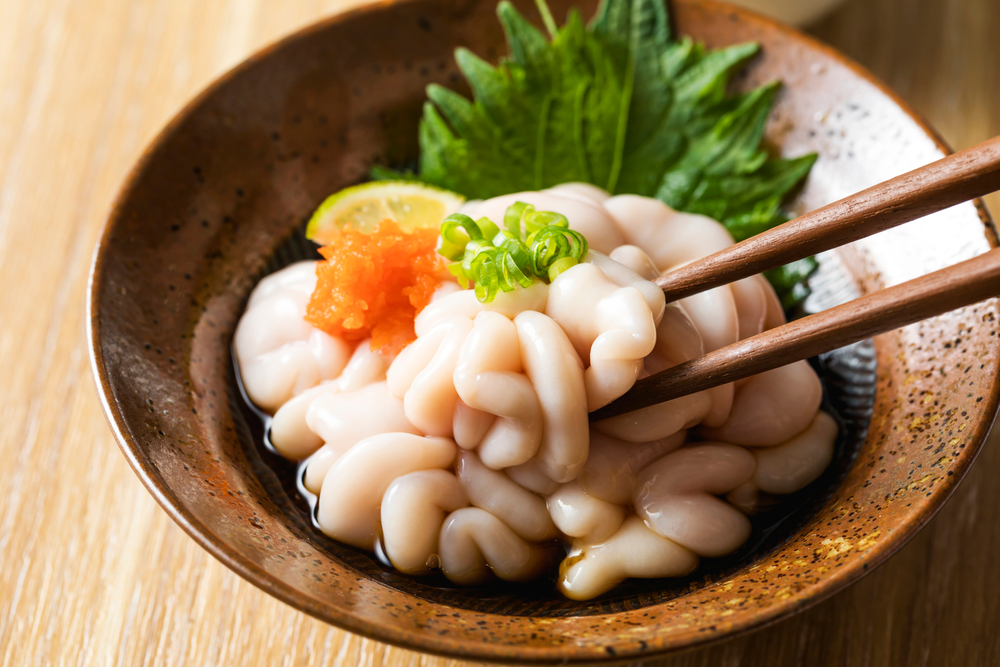
Shirako refers to the milt, or sperm sacs, of male fish such as cod, anglerfish, or pufferfish. This delicacy is esteemed for its creamy texture and delicate, slightly sweet flavor. Shirako can be enjoyed in various preparations: raw as sashimi, lightly cooked in hot pots, or deep-fried in tempura batter. Its appearance is soft and brain-like, which can be off-putting to the uninitiated. However, those who acquire a taste for shirako often appreciate its unique mouthfeel and subtle taste, reflecting the Japanese appreciation for diverse textures and flavors in cuisine.
14. Mopane Worms – Southern Africa
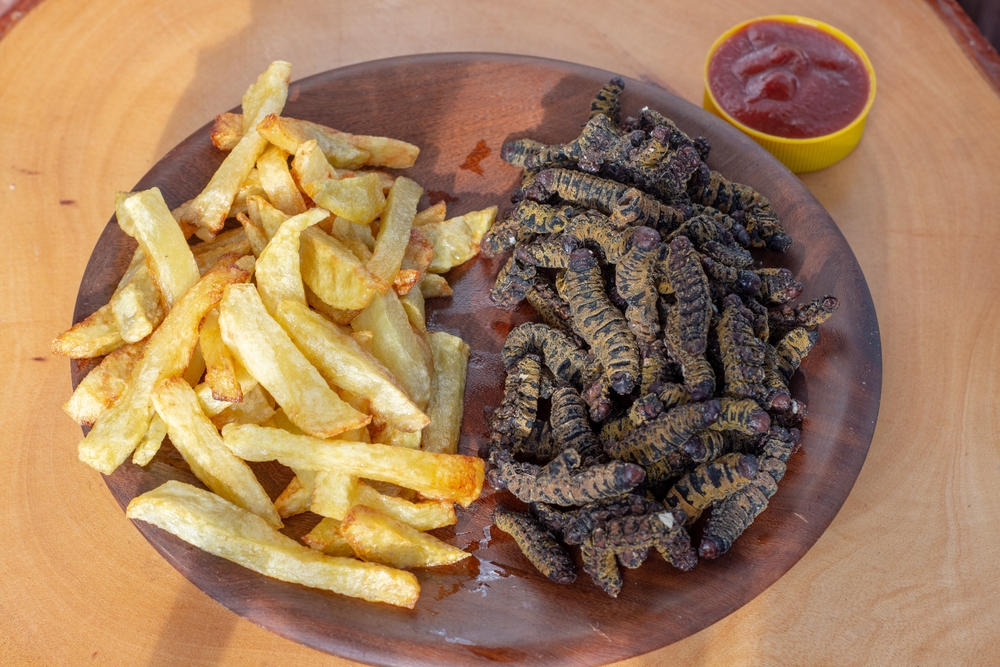
Mopane worms, the caterpillar stage of the emperor moth, are a traditional source of protein in various Southern African countries. Harvested from mopane trees, these caterpillars are typically boiled and then sun-dried or smoked, resulting in a crunchy texture. They can be eaten as a snack or rehydrated and cooked in stews with tomatoes and onions. Rich in protein and essential nutrients, mopane worms are not only a dietary staple but also an economic resource, providing income for rural communities. Their consumption highlights the sustainable use of natural resources and the cultural significance of entomophagy in the region.
15. Jellied Moose Nose – Canada

Jellied moose nose is a traditional dish among indigenous communities and hunters in Canada, particularly in the northern regions. The preparation involves boiling the nose of a moose to remove hair and soften the meat, then cooking it with onions, spices, and herbs. The mixture is allowed to cool and set, resulting in a gelatinous terrine-like dish. The texture is tender, and the flavor is mild, often compared to other head cheeses. Consuming jellied moose nose reflects a deep respect for the animal and the practice of utilizing all edible parts, embodying principles of sustainability and resourcefulness in traditional Canadian cuisine.
16. Chicken’s Feet – East Asia, Caribbean, South America, and South Africa

Chicken’s feet are a common delicacy in various regions, including East Asia, the Caribbean, South America, and South Africa. Despite being composed mainly of skin, tendons, and cartilage, they are valued for their unique texture and flavor. Typically, the feet are deep-fried, braised, or used to enrich broths and soups. In Chinese dim sum, for instance, they are often served in a savory black bean sauce. The gelatinous texture resulting from cooking is particularly appreciated in these culinary traditions. While some may find the appearance off-putting, enthusiasts praise the rich taste and the cultural significance of this unusual food. Enjoying chicken’s feet exemplifies the practice of utilizing all parts of the animal, reflecting a philosophy of culinary resourcefulness.
17. Tripe – Worldwide

Tripe refers to the edible lining from the stomachs of various animals, commonly cattle, and is consumed in many cultures worldwide. Its texture is distinctive, often described as chewy or slightly rubbery, and it readily absorbs the flavors of accompanying ingredients. Dishes featuring tripe include Italian “Trippa alla Romana,” a tomato-based stew, and Mexican “Menudo,” a spicy soup believed to have restorative properties. Preparation typically involves thorough cleaning and slow cooking to achieve the desired tenderness. While its appearance and texture may be challenging for some, tripe remains a staple in traditional cuisines, showcasing the global appreciation for this unusual food. Its consumption highlights a commitment to minimizing waste and honoring the entirety of the animal.
18. Khash – Middle East and Eastern Europe

Khash is a traditional dish enjoyed in countries across the Middle East and Eastern Europe, particularly Armenia, Georgia, and Iran. It consists of boiled cow or sheep parts, such as the head, feet, and stomach, resulting in a rich, gelatinous soup. Often consumed during colder months, khash is believed to have warming properties and is associated with communal gatherings. The preparation is time-intensive, requiring meticulous cleaning and prolonged boiling to achieve the characteristic broth. Typically, the dish is seasoned at the table with salt, garlic, and lemon juice, allowing diners to customize the flavor. Despite its humble ingredients, khash holds a place of honor in culinary traditions, symbolizing hospitality and the importance of shared meals. This unusual food exemplifies the cultural practice of utilizing all edible parts of the animal, reflecting a deep respect for resources.
19. Jellied Eels – United Kingdom
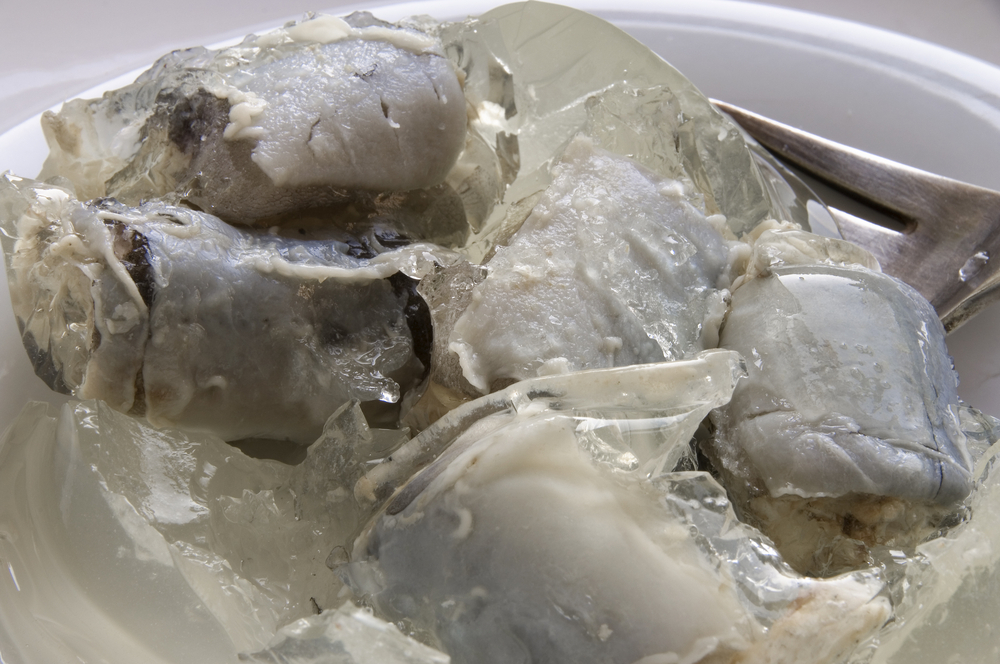
Jellied eels are a traditional English dish that originated in the 18th century, particularly associated with London’s East End. The preparation involves boiling chopped eels in a spiced stock, which, upon cooling, forms a natural gelatin around the fish pieces. Served cold, the dish has a distinctive texture and a mildly fishy flavor, often accompanied by vinegar or white pepper. Once a staple among working-class communities, jellied eels have seen a decline in popularity but remain a cultural icon. Efforts to preserve this culinary heritage continue, with dedicated eel and pie shops still operating in parts of London. While the gelatinous consistency may be unconventional to some, this unusual food offers insight into historical British cuisine and the resourceful use of local ingredients.
20. Stargazy Pie – United Kingdom

Stargazy pie is a distinctive Cornish dish featuring baked pilchards (sardines) with their heads protruding through the pastry crust, appearing to gaze skyward. Traditionally prepared in the village of Mousehole during the festival of Tom Bawcock’s Eve, the pie commemorates a legendary fisherman who braved stormy seas to feed his community. The filling typically includes pilchards, eggs, and potatoes, seasoned and baked beneath a shortcrust pastry. The unusual presentation serves a practical purpose, allowing the oils from the fish heads to infuse the pie with rich flavor. While the visual aspect may be startling, stargazy pie embodies regional pride and the celebration of local maritime heritage. This unusual food highlights the creativity inherent in traditional British cooking and the stories that shape culinary customs.
21. Witchetty Grub – Australia
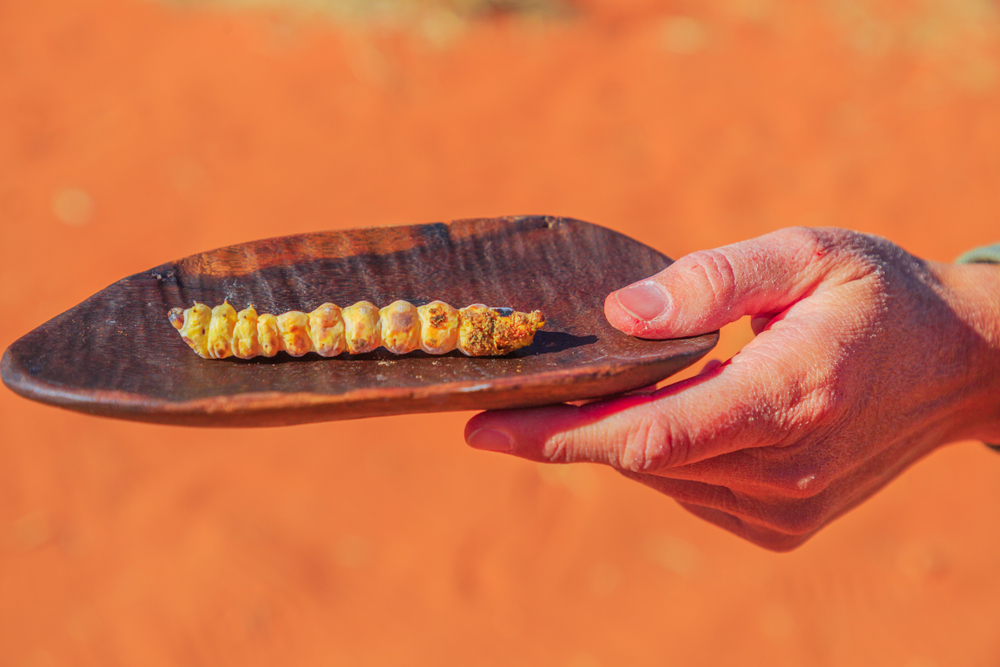
In the Australian Outback, the witchetty grub holds a special place in Indigenous cuisine. These large, white larvae are harvested from the roots of the witchetty bush and consumed either raw or cooked. When eaten raw, they have a creamy texture reminiscent of almonds. Cooking them imparts a crispy skin with a light, nutty flavor. Rich in protein and nutrients, witchetty grubs have been a vital food source for Indigenous Australians for centuries. Their consumption reflects a deep understanding of the land and its resources, showcasing the sustainability practices inherent in traditional Aboriginal culture.
22. Escargot – France
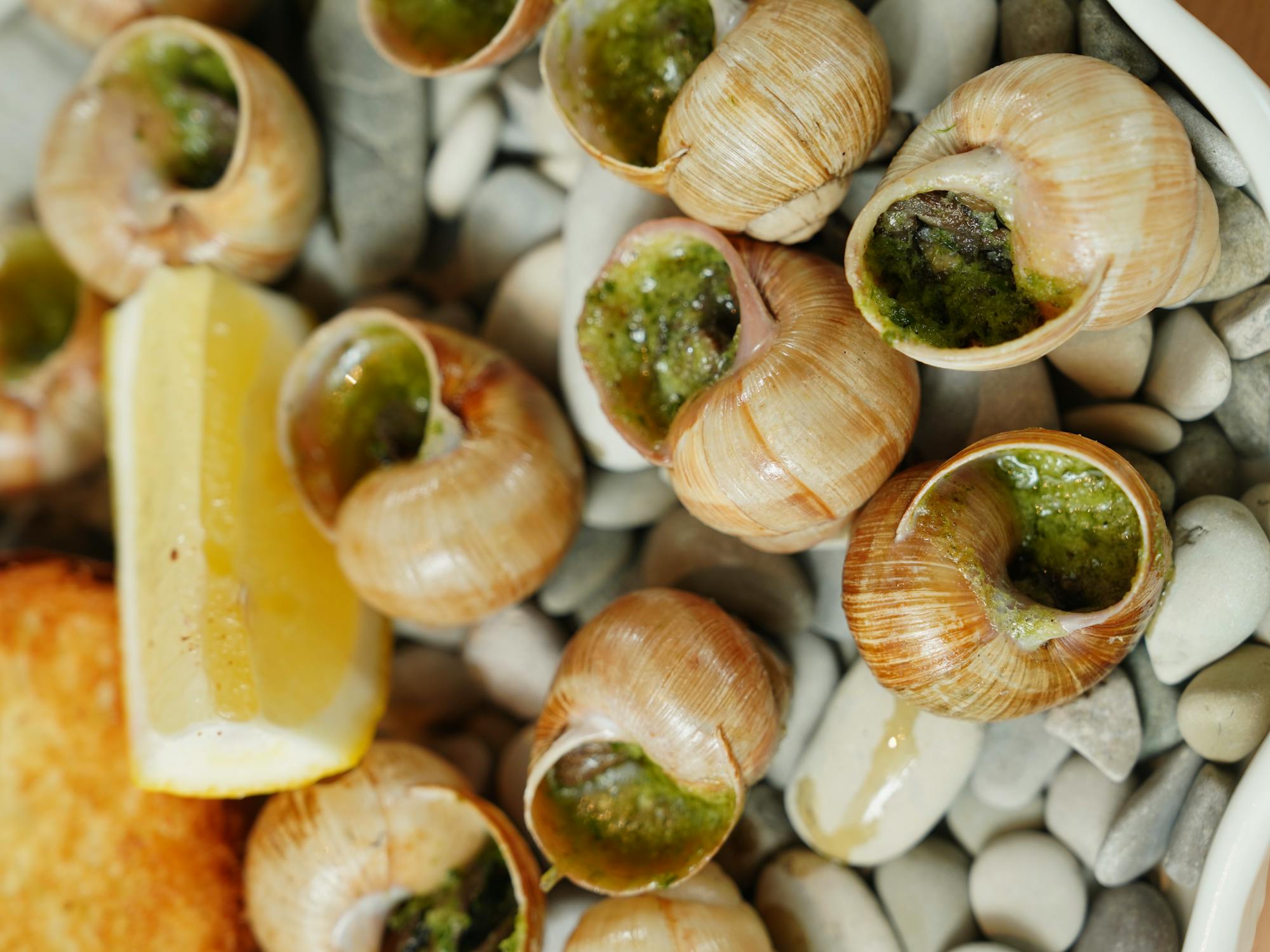
Escargot, or cooked land snails, is a celebrated delicacy in French cuisine. Typically prepared by removing the snails from their shells, they are cooked with garlic, parsley, and butter, then returned to the shells for serving. The result is a tender morsel infused with rich, herbal flavors. Often enjoyed as an appetizer, escargot is particularly popular in regions like Burgundy, where snail farming is common. This dish exemplifies the French penchant for transforming simple ingredients into gourmet experiences, highlighting the cultural appreciation for nuanced flavors and textures.
23. Black Pudding – United Kingdom and Ireland

Black pudding is a type of blood sausage traditionally consumed in the United Kingdom and Ireland. Made by combining pig’s blood with oatmeal, fat, and seasonings, the mixture is encased and cooked until firm. It is commonly sliced and fried, often accompanying breakfast dishes. The flavor is rich and earthy, with a distinctive, slightly grainy texture. Despite its unusual main ingredient, black pudding is cherished for its hearty qualities and deep-rooted presence in regional culinary traditions.
Read More: 7 Of The Best Fast-Food Breakfast Sandwiches, Ranked
24. Tuna Eyeballs – Japan
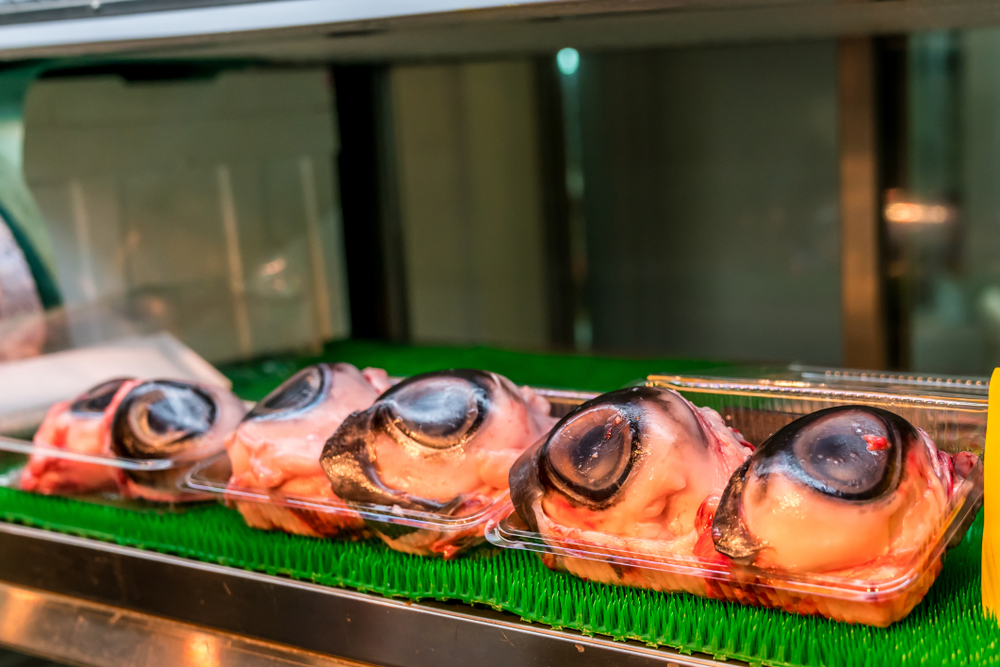
In Japan, tuna eyeballs are considered a delicacy, often found in izakayas and seafood markets. These large eyeballs are typically simmered or steamed with soy sauce, mirin, and ginger, resulting in a gelatinous texture with a mild, seafood flavor. Rich in omega-3 fatty acids and proteins, they are valued for their nutritional benefits. While the appearance may be daunting, those who try tuna eyeballs often find the taste pleasant and the experience uniquely memorable, reflecting the Japanese ethos of minimizing waste and honoring the entirety of the catch.
25. Lutefisk – Scandinavia
![Lutfisk - Lutefisk,in Northern and Central Norway,] in Southern Norway in Sweden and in Finland a traditional dish of some Nordic countries.made from aged stockfish (](https://secretlifeofmom.com/wp-content/uploads/2025/03/shutterstock_227827372.jpg)
Lutefisk is a traditional Scandinavian dish made from dried whitefish, typically cod, that has been soaked in a lye solution and then rehydrated. This process gives the fish a distinctive gelatinous texture and a strong, characteristic aroma. Lutefisk is usually served with boiled potatoes, peas, and a white sauce or melted butter. Despite its challenging texture and preparation method, it remains a beloved dish in Norway and Sweden, especially during the Christmas season, symbolizing heritage and communal celebration.
26. Deep-Fried Butter – United States

Deep-fried butter has become an iconic fairground treat across the United States, known for its indulgence. It starts by taking sticks of butter and freezing them solid, making them easier to handle. Each frozen piece is dipped generously in a sweet batter, then quickly submerged in hot oil until crispy and golden. When freshly fried, the butter melts, creating a rich, gooey center that’s both salty and sweet. Vendors often enhance its flavor by topping it with powdered sugar, cinnamon, or drizzles of maple syrup. Though not an everyday snack, it embodies the playful creativity and excess associated with American carnival cuisine. While certainly not a health food, deep-fried butter continues to attract curious diners looking for a unique culinary experience.
27. Bird’s Nest Soup – China

Bird’s nest soup is an elegant Chinese delicacy, famous for its rarity and alleged health benefits. The primary ingredient is swiftlet nests, carefully harvested from caves and cliffs in Southeast Asia. These nests are unique because swiftlets construct them entirely from their saliva, resulting in a delicate structure that’s rich in nutrients. After careful cleaning, cooks simmer the nests gently in chicken broth or mildly sweetened water, creating a silky, jelly-like texture. Often served at banquets and celebrations, it’s valued for its subtle taste and reputation as a beauty-enhancing food. Chinese tradition holds that consuming bird’s nest soup improves skin health, boosts the immune system, and provides overall vitality. Despite its high cost, bird’s nest soup remains popular, reflecting centuries-old traditions of fine Chinese cuisine.
28. Cuy (Guinea Pig) – Peru and Ecuador
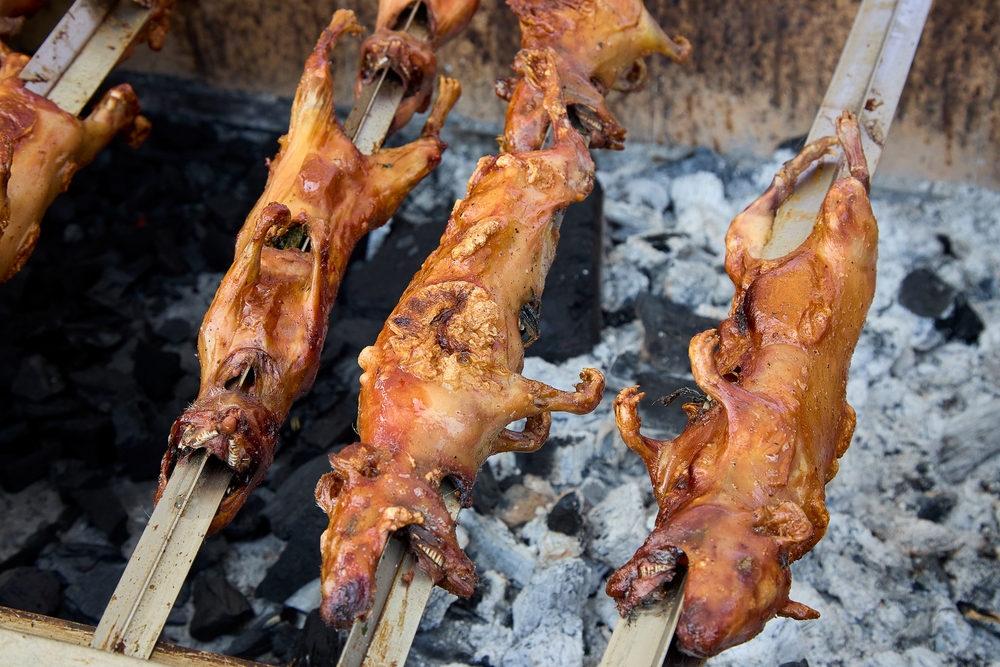
Cuy, or guinea pig, is a traditional delicacy in Peru and Ecuador, where it has been enjoyed for thousands of years. The meat is typically roasted whole or grilled, seasoned generously with local herbs, spices, and garlic, creating a crispy, flavorful skin. Often served during special celebrations or festivals, cuy remains an important part of Andean cultural heritage. Diners frequently describe the flavor as rich and reminiscent of rabbit or dark poultry meat, with a tender yet slightly gamey taste. Traditionally accompanied by potatoes, corn, and spicy sauces, cuy symbolizes hospitality and respect in these communities. Although unusual to visitors unfamiliar with Andean cuisine, this dish offers a unique insight into local traditions and culinary creativity. Eating cuy connects diners to a culinary practice deeply rooted in the region’s history.
29. Durian – Southeast Asia

Durian, known widely as Southeast Asia’s “king of fruits,” is famous (or infamous) for its powerful aroma. Native to countries such as Thailand, Malaysia, and Indonesia, this spiky fruit emits a smell so intense it’s often banned from hotels and public transport. However, beneath its intimidating exterior and strong scent, durian has a rich, creamy texture that fans describe as heavenly. The taste blends notes of sweetness, custard, and almonds, earning passionate devotion from locals. Often enjoyed fresh, durian is also incorporated into desserts, candies, and even ice cream throughout the region. Its divisive smell makes it an adventurous food experience for travelers, while locals appreciate it as a treasured delicacy. Durian captures the essence of how unusual foods can become beloved cultural icons.
30. Cockroach Milk – Potential Superfood

Cockroach milk might sound off-putting, but scientists see it as a possible nutritional breakthrough. The milk is produced by the Pacific beetle cockroach, specifically to nourish their offspring. Remarkably, this “milk” contains proteins, amino acids, sugars, and fats, making it incredibly nutrient-rich. In fact, research suggests cockroach milk has three times more calories per serving than buffalo milk, the previously known richest animal milk. Currently, producing cockroach milk on a large scale isn’t practical, but researchers are exploring ways to replicate its nutritional profile artificially. Advocates believe it could offer a sustainable and highly nutritious alternative to traditional dairy sources. While not available in stores yet, cockroach milk underscores the potential of insects as future foods, pointing toward creative solutions for global nutrition challenges.
Read More: 10+ Foods Most Likely to Be Contaminated with Microplastics

